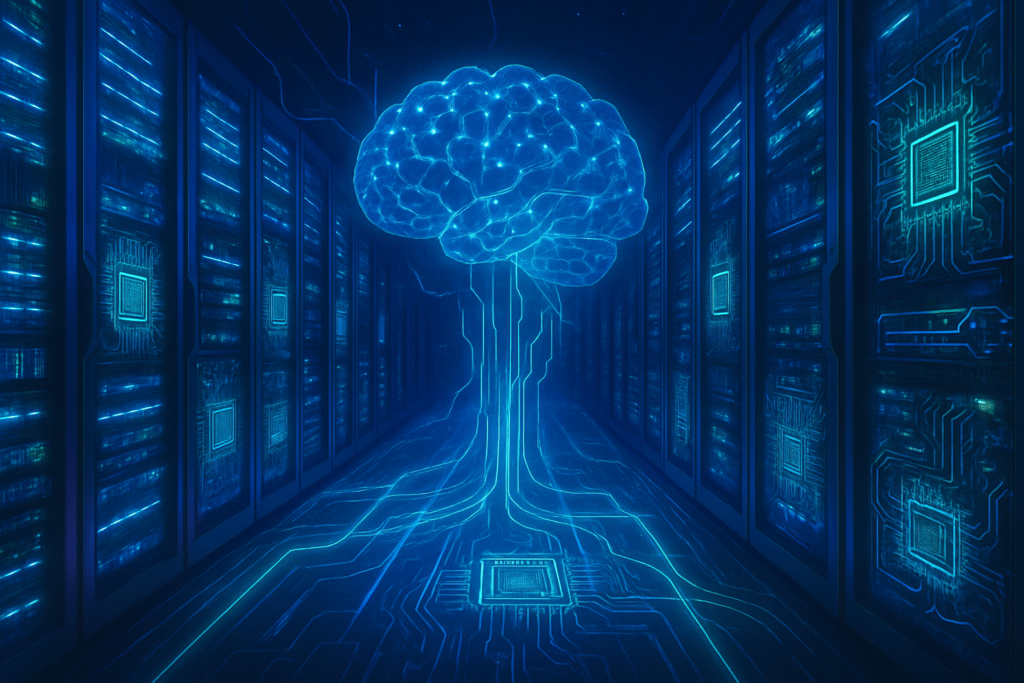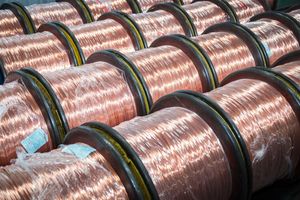
The global technology landscape, as of October 2025, is undergoing a profound and transformative shift, driven by the insatiable appetite of hyperscale data centers for advanced computing power. This surge, primarily fueled by the burgeoning artificial intelligence (AI) boom, is not merely increasing demand for semiconductors; it is fundamentally reshaping chip design, manufacturing processes, and the entire ecosystem of the tech industry. Hyperscalers, the titans of cloud computing, are now the foremost drivers of semiconductor innovation, dictating the specifications for the next generation of silicon.
This "AI Supercycle" marks an unprecedented era of capital expenditure and technological advancement. The data center semiconductor market is projected to expand dramatically, from an estimated $209 billion in 2024 to nearly $500 billion by 2030, with the AI chip market within this segment forecasted to exceed $400 billion by 2030. Companies like Amazon (NASDAQ: AMZN), Google (NASDAQ: GOOGL), Microsoft (NASDAQ: MSFT), and Meta (NASDAQ: META) are investing tens of billions annually, signaling a continuous and aggressive build-out of AI infrastructure. This massive investment underscores a strategic imperative: to control costs, optimize performance, and reduce reliance on third-party suppliers, thereby ushering in an era of vertical integration where hyperscalers design their own custom silicon.
The Technical Core: Specialized Chips for a Cloud-Native AI Future
The evolution of cloud computing chips is a fundamental departure from traditional, general-purpose silicon, driven by the unique requirements of hyperscale environments and AI-centric workloads. Hyperscalers demand a diverse array of chips, each optimized for specific tasks, with an unyielding emphasis on performance, power efficiency, and scalability.
While AI accelerators handle intensive machine learning (ML) tasks, Central Processing Units (CPUs) remain the backbone for general-purpose computing and orchestration. A significant trend here is the widespread adoption of Arm-based CPUs. Hyperscalers like AWS (Amazon Web Services), Google Cloud, and Microsoft Azure are deploying custom Arm-based chips, projected to account for half of the compute shipped to top hyperscalers by 2025. These custom Arm CPUs, such as AWS Graviton4 (96 cores, 12 DDR5-5600 memory channels) and Microsoft's Azure Cobalt 100 CPU (128 Arm Neoverse N2 cores, 12 channels of DDR5 memory), offer significant energy and cost savings, along with superior performance per watt compared to traditional x86 offerings.
However, the most critical components for AI/ML workloads are Graphics Processing Units (GPUs) and AI Accelerators (ASICs/TPUs). High-performance GPUs from NVIDIA (NASDAQ: NVDA) (e.g., Hopper H100/H200, Blackwell B200/B300, and upcoming Rubin) and AMD (NASDAQ: AMD) (MI300 series) remain dominant for training large AI models due to their parallel processing capabilities and robust software ecosystems. These chips feature massive computational power, often exceeding exaflops, and integrate large capacities of High-Bandwidth Memory (HBM). For AI inference, there's a pivotal shift towards custom ASICs. Google's 7th-generation Tensor Processing Unit (TPU), Ironwood, unveiled at Cloud Next 2025, is primarily optimized for large-scale AI inference, achieving an astonishing 42.5 exaflops of AI compute with a full cluster. Microsoft's Azure Maia 100, extensively deployed by 2025, boasts 105 billion transistors on a 5-nanometer TSMC (NYSE: TSM) process and delivers 1,600 teraflops in certain formats. OpenAI, a leading AI research lab, is even partnering with Broadcom (NASDAQ: AVGO) and TSMC to produce its own custom AI chips using a 3nm process, targeting mass production by 2026. These chips now integrate over 250GB of HBM (e.g., HBM4) to support larger AI models, utilizing advanced packaging to stack memory adjacent to compute chiplets.
Field-Programmable Gate Arrays (FPGAs) offer flexibility for custom AI algorithms and rapidly evolving workloads, while Data Processing Units (DPUs) are critical for offloading networking, storage, and security tasks from main CPUs, enhancing overall data center efficiency.
The design evolution is marked by a fundamental departure from monolithic chips. Custom silicon and vertical integration are paramount, allowing hyperscalers to optimize chips specifically for their unique workloads, improving price-performance and power efficiency. Chiplet architecture has become standard, overcoming monolithic design limits by building highly customized systems from smaller, specialized blocks. Google's Ironwood TPU, for example, is its first multiple compute chiplet die. This is coupled with leveraging the most advanced process nodes (5nm and below, with TSMC planning 2nm mass production by Q4 2025) and advanced packaging techniques like TSMC's CoWoS-L. Finally, the increased power density of these AI chips necessitates entirely new approaches to data center design, including higher direct current (DC) architectures and liquid cooling, which is becoming essential (Microsoft's Maia 100 is only deployed in water-cooled configurations).
The AI research community and industry experts largely view these developments as a necessary and transformative phase, driving an "AI supercycle" in semiconductors. While acknowledging the high R&D costs and infrastructure overhauls required, the move towards vertical integration is seen as a strategic imperative to control costs, optimize performance, and secure supply chains, fostering a more competitive and innovative hardware landscape.
Corporate Chessboard: Beneficiaries, Battles, and Strategic Shifts
The escalating demand for specialized chips from hyperscalers and data centers is profoundly reshaping the competitive landscape for AI companies, tech giants, and startups. This "AI Supercycle" has led to an unprecedented growth phase in the AI chip market, projected to reach over $150 billion in sales in 2025.
NVIDIA remains the undisputed dominant force in the AI GPU market, holding approximately 94% market share as of Q2 2025. Its powerful Hopper and Blackwell GPU architectures, combined with the robust CUDA software ecosystem, provide a formidable competitive advantage. NVIDIA's data center revenue has seen meteoric growth, and it continues to accelerate its GPU roadmap with annual updates. However, the aggressive push by hyperscalers (Amazon, Google, Microsoft, Meta) into custom silicon directly challenges NVIDIA's pricing power and market share. Their custom chips, like AWS's Trainium/Inferentia, Google's TPUs, and Microsoft's Azure Maia, position them to gain significant strategic advantages in cost-performance and efficiency for their own cloud services and internal AI models. AWS, for instance, is deploying its Trainium chips at scale, claiming better price-performance compared to NVIDIA's latest offerings.
TSMC (Taiwan Semiconductor Manufacturing Company Limited) stands as an indispensable partner, manufacturing advanced chips for NVIDIA, AMD, Apple (NASDAQ: AAPL), and the hyperscalers. Its leadership in advanced process nodes and packaging technologies like CoWoS solidifies its critical role. AMD is gaining significant traction with its MI series (MI300, MI350, MI400 roadmap) in the AI accelerator market, securing billions in AI accelerator orders for 2025. Other beneficiaries include Broadcom (NASDAQ: AVGO) and Marvell Technology (NASDAQ: MRVL), benefiting from demand for custom AI accelerators and advanced networking chips, and Astera Labs (NASDAQ: ALAB), seeing strong demand for its interconnect solutions.
The competitive implications are intense. Hyperscalers' vertical integration is a direct response to the limitations and high costs of general-purpose hardware, allowing them to fine-tune every aspect for their native cloud environments. This reduces reliance on external suppliers and creates a more diversified hardware landscape. While NVIDIA's CUDA platform remains strong, the proliferation of specialized hardware and open alternatives (like AMD's ROCm) is fostering a more competitive environment. However, the astronomical cost of developing advanced AI chips creates significant barriers for AI startups, centralizing AI power among well-resourced tech giants. Geopolitical tensions, particularly export controls, further fragment the market and create production hurdles.
This shift leads to disruptions such as delayed product development due to chip scarcity, and a redefinition of cloud offerings, with providers differentiating through proprietary chip architectures. Infrastructure innovation extends beyond chips to advanced cooling technologies, like Microsoft's microfluidics, to manage the extreme heat generated by powerful AI chips. Companies are also moving from "just-in-time" to "just-in-case" supply chain strategies, emphasizing diversification.
Broader Horizons: AI's Foundational Shift and Global Implications
The hyperscaler-driven chip demand is inextricably linked to the broader AI landscape, signaling a fundamental transformation in computing and society. The current era is characterized by an "AI supercycle," where the proliferation of generative AI and large language models (LLMs) serves as the primary catalyst for an unprecedented hunger for computational power. This marks a shift in semiconductor growth from consumer markets to one primarily fueled by AI data center chips, making AI a fundamental layer of modern technology, driving an infrastructural overhaul rather than a fleeting trend. AI itself is increasingly becoming an indispensable tool for designing next-generation processors, accelerating innovation in custom silicon.
The impacts are multifaceted. The global AI chip market is projected to contribute over $15.7 trillion to global GDP by 2030, transforming daily life across various sectors. The surge in demand has led to significant strain on supply chains, particularly for advanced packaging and HBM chips, driving strategic partnerships like OpenAI's reported $10 billion order for custom AI chips from Broadcom, fabricated by TSMC. This also necessitates a redefinition of data center infrastructure, moving towards new modular designs optimized for high-density GPUs, TPUs, and liquid cooling, with older facilities being replaced by massive, purpose-built campuses. The competitive landscape is being transformed as hyperscalers become active developers of custom silicon, challenging traditional chip vendors.
However, this rapid advancement comes with potential concerns. The immense computational resources for AI lead to a substantial increase in electricity consumption by data centers, posing challenges for meeting sustainability targets. Global projections indicate AI's energy demand could double from 260 terawatt-hours in 2024 to 500 terawatt-hours in 2027. Supply chain bottlenecks, high R&D costs, and the potential for centralization of AI power among a few tech giants are also significant worries. Furthermore, while custom ASICs offer optimization, the maturity of ecosystems like NVIDIA's CUDA makes it easier for developers, highlighting the challenge of developing and supporting new software stacks for custom chips.
In terms of comparisons to previous AI milestones, this current era represents one of the most revolutionary breakthroughs, overcoming computational barriers that previously led to "AI Winters." It's characterized by a fundamental shift in hardware architecture – from general-purpose processors to AI-optimized chips (GPUs, ASICs, NPUs), high-bandwidth memory, and ultra-fast interconnect solutions. The economic impact and scale of investment surpass previous AI breakthroughs, with AI projected to transform daily life on a societal level. Unlike previous milestones, the sheer scale of current AI operations brings energy consumption and sustainability to the forefront as a critical challenge.
The Road Ahead: Anticipating AI's Next Chapter
The future of hyperscaler and data center chip demand is characterized by continued explosive growth and rapid innovation. The semiconductor market for data centers is projected to grow significantly, with the AI chip market alone expected to surpass $400 billion by 2030.
Near-term (2025-2027) and long-term (2028-2030+) developments will see GPUs continue to dominate, but AI ASICs will accelerate rapidly, driven by hyperscalers' pursuit of vertical integration and cost control. The trend of custom silicon will extend beyond CPUs to XPUs, CXL devices, and NICs, with Arm-based chips gaining significant traction in data centers. R&D will intensely focus on resolving bottlenecks in memory and interconnects, with HBM market revenue expected to reach $21 billion in 2025, and CXL gaining traction for memory disaggregation. Advanced packaging techniques like 2.5D and 3D integration will become essential for high-performance AI systems.
Potential applications and use cases are boundless. Generative AI and LLMs will remain primary drivers, pushing the boundaries for training and running increasingly larger and more complex multimodal AI models. Real-time AI inference will skyrocket, enabling faster AI-powered applications and smarter assistants. Edge AI will proliferate into enterprise and edge devices for real-time applications like autonomous transport and intelligent factories. AI's influence will also expand into consumer electronics, with AI-enabled PCs expected to make up 43% of all shipments by the end of 2025, and the automotive sector becoming the fastest-growing segment for AI chips.
However, significant challenges must be addressed. The immense power consumption of AI data centers necessitates innovations in energy-efficient designs and advanced cooling solutions. Manufacturing complexity and capacity, along with a severe talent shortage, pose technical hurdles. Supply chain resilience remains critical, prompting diversification and regionalization. The astronomical cost of advanced AI chip development creates high barriers to entry, and the slowdown of Moore's Law pushes semiconductor design towards new directions like 3D, chiplets, and complex hybrid packages.
Experts predict that AI will continue to be the primary driver of growth in the semiconductor industry, with hyperscale cloud providers remaining major players in designing and deploying custom silicon. NVIDIA's role will evolve as it responds to increased competition by offering new solutions like NVLink Fusion to build semi-custom AI infrastructure with hyperscalers. The focus will be on flexible and scalable architectures, with chiplets being a key enabler. The AI compute cycle has accelerated significantly, and massive investment in AI infrastructure will continue, with cloud vendors' capital expenditures projected to exceed $360 billion in 2025. Energy efficiency and advanced cooling will be paramount, with approximately 70% of data center capacity needing to run advanced AI workloads by 2030.
A New Dawn for AI: The Enduring Impact of Hyperscale Innovation
The demand from hyperscalers and data centers has not merely influenced; it has fundamentally reshaped the semiconductor design landscape as of October 2025. This period marks a pivotal inflection point in AI history, akin to an "iPhone moment" for data centers, driven by the explosive growth of generative AI and high-performance computing. Hyperscalers are no longer just consumers but active architects of the AI revolution, driving vertical integration from silicon to services.
Key takeaways include the explosive market growth, with the data center semiconductor market projected to nearly halve a trillion dollars by 2030. GPUs remain dominant, but custom AI ASICs from hyperscalers are rapidly gaining momentum, leading to a diversified competitive landscape. Innovations in memory (HBM) and interconnects (CXL), alongside advanced packaging, are crucial for supporting these complex systems. Energy efficiency has become a core requirement, driving investments in advanced cooling solutions.
This development's significance in AI history is profound. It represents a shift from general-purpose computing to highly specialized, domain-specific architectures tailored for AI workloads. The rapid iteration in chip design, with development cycles accelerating, demonstrates the urgency and transformative nature of this period. The ability of hyperscalers to invest heavily in hardware and pre-built AI services is effectively democratizing AI, making advanced capabilities accessible to a broader range of users.
The long-term impact will be a diversified semiconductor landscape, with continued vertical integration and ecosystem control by hyperscalers. Sustainable AI infrastructure will become paramount, driving significant advancements in energy-efficient designs and cooling technologies. The "AI Supercycle" will ensure a sustained pace of innovation, with AI itself becoming a tool for designing advanced processors, reshaping industries for decades to come.
In the coming weeks and months, watch for new chip launches and roadmaps from NVIDIA (Blackwell Ultra, Rubin Ultra), AMD (MI400 line), and Intel (Gaudi accelerators). Pay close attention to the deployment and performance benchmarks of custom silicon from AWS (Trainium2), Google (TPU v6), Microsoft (Maia 200), and Meta (Artemis), as these will indicate the success of their vertical integration strategies. Monitor TSMC's mass production of 2nm chips and Samsung's accelerated HBM4 memory development, as these manufacturing advancements are crucial. Keep an eye on the increasing adoption of liquid cooling solutions and the evolution of "agentic AI" and multimodal AI systems, which will continue to drive exponential growth in demand for memory bandwidth and diverse computational capabilities.
This content is intended for informational purposes only and represents analysis of current AI developments.
TokenRing AI delivers enterprise-grade solutions for multi-agent AI workflow orchestration, AI-powered development tools, and seamless remote collaboration platforms. For more information, visit https://www.tokenring.ai/.







